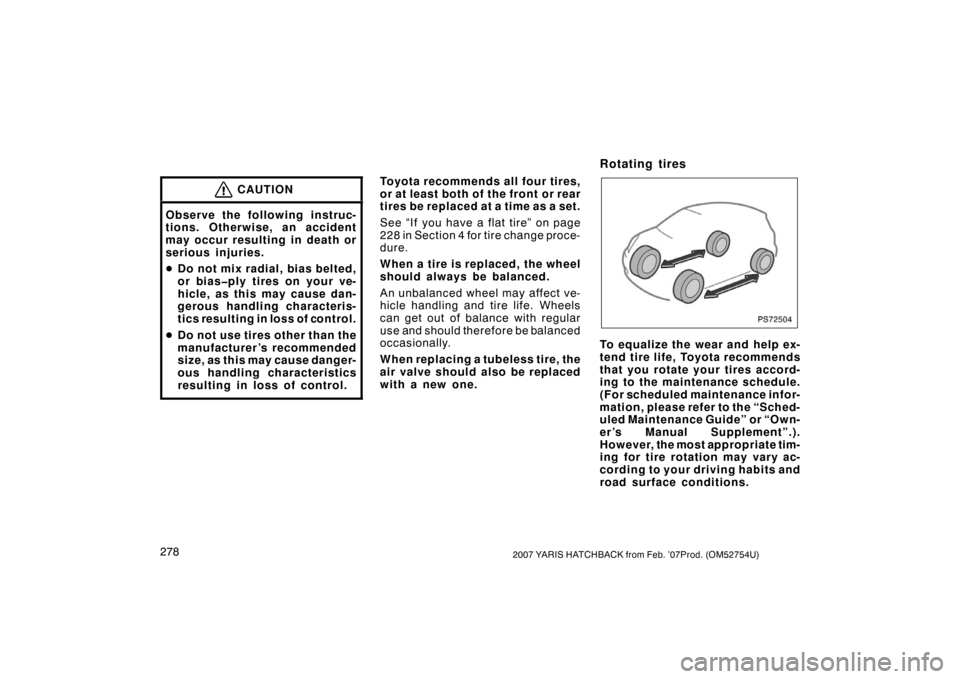Page 284 of 313
2762007 YARIS HATCHBACK from Feb. ’07Prod. (OM52754U)
CAUTION
Keep your tires properly inflated.
Otherwise, the following condi-
tions may occur and cause an ac-
cident resulting in death or seri-
ous injuries.
Low tire pressure (underinfla-
tion)—
� Excessive wear
� Uneven wear
� Poor handling
� Possibility of blowouts from an
overheated tire
� Poor sealing of the tire bead
� Wheel deformation and/or tire
separation
� A greater possibility of tire
damage from road hazards
High tire pressure (overinfla-
tion)—
�Poor handling
� Excessive wear
� Uneven wear
� A greater possibility of tire
damage from road hazards
Checking and replacing tires
Tread wear indicator
CHECKING YOUR TIRES
Check the tire’s tread for tread
wear indicators. If the indicators
show, replace the tires. The loca-
tion of tread wear indicators is
shown by the “TWI” or “
Δ” marks,
etc., molded on the sidewall of
each tire.
Page 285 of 313

2772007 YARIS HATCHBACK from Feb. ’07Prod. (OM52754U)
The tires on your Toyota have built−in
tread wear indicators to help you
know when the tires need replace-
ment. When the tread depth wears to
1.6 mm (0.06 in.) or less, the indica-
tors will appear. If you can see the
indicators in two or more adjacent
grooves, the tire should be replaced.
The lower the tread, the higher the
risk of skidding.
The effectiveness of snow tires is
lost if the tread wears down below
4 mm (0.16 in.).
If you have tire damage such as
cuts, splits, cracks deep e nough to
expose the fabric, or bulges indi-
cating internal damage, the tire
should be repl aced.
If a tire often goes flat or cannot be
properly repaired due to the size or
location of a cut or other damage, it
should be replaced. If you are not
sure, consult with your Toyota dealer. If air loss occurs while driving, do not
continue driving. Driving even a short
distance can damage a tire beyond
repair.
An y ti res wh i ch are over 6 years
old must be checked by a qualified
technician even if damage is not
obvious.
Tires deteriorate with age even if they
have never or seldom been used.
This applies also to the spare tire and
tires stored for future use.
REPLACING YOUR TIRES
When replacing a tire, use a tire of
the same size and construction,
and the same or greater maximum
load as the originally installed
tires.
Using any other size or type of tire
may seriously affect handling, ride,
speedometer/odometer calibration,
ground clearance, and clearance be-
tween the body and tires or snow
chains.
Check that the maximum load of the
replaced tire is greater than 1/2 of the
Gross Axle Weight Ratings (GAWR)
of either the front axle or the rear
axle, whichever is greater. As for the
maximum load of the tire, see the load
limit at maximum cold tire inflation
pressure mentioned on the sidewall
of the tire, and as for the Gross Axle
Weight Ratings (GAWR), see the Cer-
tification Label.
For details about the sidewall of the
tire and the Certification Label, see
pages 191 and 188.
Page 286 of 313

2782007 YARIS HATCHBACK from Feb. ’07Prod. (OM52754U)
CAUTION
Observe the following instruc-
tions. Otherwise, an accident
may occur resulting in death or
serious injuries.
�Do not mix radial, bias belted,
or bias�ply tires on your ve-
hicle, as this may cause dan-
gerous handling characteris-
tics resulting in loss of control.
� Do not use tires other than the
manufacturer’s recommended
size, as this may cause danger-
ous handling characteristics
resulting in loss of control.
Toyota recommends all four tires,
or at least both of the front or rear
tires be replaced at a time as a set.
See “If you have a flat tire” on page
228 in Section 4 for tire change proce-
dure.
When a tire is replaced, the wheel
should always be balanced.
An unbalanced wheel may affect ve-
hicle handling and tire life. Wheels
can get out of balance with regular
use and should therefore be balanced
occasionally.
When replacing a tubeless tire, the
air valve should also be repl aced
w i t h a new on e.
Rotating tires
PS72504
To equalize the wear and help ex-
tend tire life, Toyota recommends
that you rotate your tires accord-
ing to the maintenance schedule.
(For scheduled maintenance infor-
mation, please refer to the “Sched-
uled Maintenance Guide” or “Own-
er’s Manual Supplement”.).
However, the most appropriate tim-
ing for tire rotation may vary ac-
cording to your driving habits and
road surface conditions.
Page 287 of 313

2792007 YARIS HATCHBACK from Feb. ’07Prod. (OM52754U)
See “If you have a flat tire” on page
228 in Section 4 for tire change proce-
dure.
When rotating tires, check for uneven
wear and damage. Abnormal wear is
usually caused by incorrect tire pres-
sure, improper wheel alignment, out−
of −balance wheels, or severe braking.
CAUTION
Do not include a compact spare
tire when rotating the tires. It is
designed for temporary use only.
WHEN TO USE SNOW TIRES OR
CHAINS
Snow tires or chains are recommended
when driving on snow or ice.
On wet or dry roads, conventional tires
provide better traction than snow tires.
SNOW TIRE SELECTION
If you need snow tires, select tires of
the same size, construction and load
capacity as the originally installed tires.
Do not use tires other than those men-
tioned above. Do not install studded tires
without first checking local regulations for
possible restrictions.
CAUTION
Do not use snow tires other than the
manufacturer ’s recommended size, as
this may cause dangerous handling
characteristics resulting in loss of
control. Otherwise, an accident may
occur resulting in death or serious
injuries.
SNOW TIRE INSTALLATION
Snow tires should be installed on all
wheels.
Installing snow tires on the front wheels
only can lead to an excessive difference
in road grip capability between the front
and rear tires which could cause loss of
vehicle control.
When storing removed tires you should
store them in a cool dry place.
Mark the direction of rotation and be sure
to install them in the same direction when
replacing.
CAUTION
�Do not drive with the snow tires
incorrectly inflated.
�Never drive over 120 km/h (75 mph)
with any type of snow tires.
Installing snow tires and
chains
Page 307 of 313
2992007 YARIS HATCHBACK from Feb. ’07Prod. (OM52754U)
Tires
Tire size and cold tire inflation pressure:
Front and rearkPa (kgf/cm
2 or bar, psi)
Ti r e siz e
FrontRearWheel size
P175/65R14 81S220 (2.2, 32)220 (2.2, 32)14 x 5J
P185/60R15 84T220 (2.2, 32)220 (2.2, 32)15 x 5 1/ 2J
For sustained high speeds above 160 km/h (100 mph), in countries where such speeds are permitted by law, add
20 kPa (0.2 kgf/cm2 or bar, 3 psi) to the front tires and rear tires, but never exceed the maximum cold tire inflation
pressure molded on the tire sidewall.
Spare
Ti r e siz e
Tire inflation pressure kPa (kgf/cm2 or bar, psi)Wheel size
T125/70D15 95M420 (4.2, 60)15 x 4T
Wheel nut torque, N·m (kgf·m, ft·Ibf):103 (10.5, 76)
NOTE: For a complete information on tires (e.g. replacing tires or replacing wheels), see “Checking tire inflation pressure” through “Aluminum wheel precautions”, page 274 through 281 in Section 7 −2.
Page 313 of 313

Publication No. OM52754U
Part No. 01999-52754
Printed in Japan 01−0702 −00
(U)
U �4
I
Quick index
� If a service reminder indicator or warning buzzer comes on 114 . . . . . . .
� If your vehicle will not start 222 . . . . . . . . . . . . . . . . . . . . . . . . . . . . . . . . . . . . .\
.
� If your engine stalls while driving 226 . . . . . . . . . . . . . . . . . . . . . . . . . . . . . . . . .
� If you cannot increase engine speed 226 . . . . . . . . . . . . . . . . . . . . . . . . . . . . . .
� If your vehicle overheats 227 . . . . . . . . . . . . . . . . . . . . . . . . . . . . . . . . . . . . .\
. . . .
� If you have a flat tire 228 . . . . . . . . . . . . . . . . . . . . . . . . . . . . . . . . . . . . .\
. . . . . . .
� If your vehicle needs to be towed 240 . . . . . . . . . . . . . . . . . . . . . . . . . . . . . . . .
� Tips for driving during break-in period 178 . . . . . . . . . . . . . . . . . . . . . . . . . . . . .
� How to start the engine 208 . . . . . . . . . . . . . . . . . . . . . . . . . . . . . . . . . . . . .\
. . . . .
� General maintenance 257 . . . . . . . . . . . . . . . . . . . . . . . . . . . . . . . . . . . . .\
. . . . . . . .
Gas station information
Fuel type:
UNLEADED gasoline, Octane Rating 87 (Research Octane Number 91)
or higher
See page 178 for detailed information.
Fuel tank capacity:
42 L (11.1 gal., 9.2 lmp.gal.)
Engine oil:
ILSAC multigrade engine oil is recommended.
See page 271 for detailed information.
Tire information: See pages 274 through 281.
Tire inflation pressure: See page 299.
2007 YARIS HATCHBACK from Feb. ’07Prod. (OM52754U)